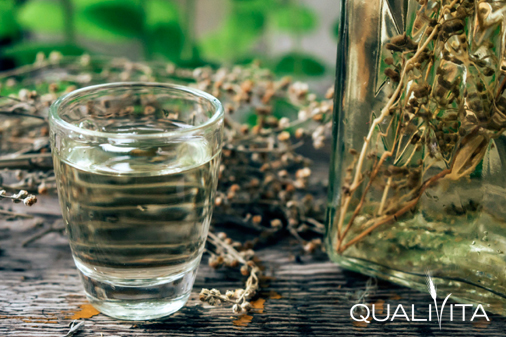Description
The Genepì della Valle D’Aosta Geographical Indication refers to a liqueur obtained by extracting the active ingredients of plants belonging to the species Artemisia genipi Weber, Artemisia mutellina Vill., Artemisia glacialis L., Artemisia nivalis Br.-Bl., Artemisia petrosa Jan., through the maceration or suspension of the same plants in hydroalcoholic solution, or using flavour mixtures obtained through the extraction of the above-mentioned plants. The wormwood must come from the harvesting of wild plants and/or crops located in the identified production area. Both dynamic and static extraction methods can be used.
Production Area
The production area of Genepì della Valle D’Aosta GI is within the municipalities situated in the Aosta Valley. The optimal altitude for cultivation is higher than 1400 metres a.s.l. for land on the Adret side (in Valle D’Aosta this term refers to the sunny slope), and higher than 1350 metres a.s.l. for the less sunny land on the Envers side (in Valle D’Aosta this term refers to the shady slope). The wild and/or cultivated wormwood plants can only be harvested within the boundaries of the Valle D’Aosta region. Genepì della Valle d 'Aosta GI can only be bottled in the production area, in order to guarantee that the product maintains its characteristics for the final consumer.
Production Method
Genepì della Valle D’Aosta GI obtained through maceration is made by leaving the fresh or dried plants to steep in a hydroalcoholic solution with a minimum alcohol content of 55% ABV, for at least 8 days. The length of the extraction process can vary if techniques other than maceration are used. The liqueur obtained through “suspension” is made by placing the dried plants on special grills suspended over the hydroalcoholic solution, in hermetically sealed containers where the alcohol-saturated headspace extracts the volatile compounds of the plants. After the extraction process the pulp is added to a mixture of water and sugar to complete the liqueur. A portion of the pulp can be distilled in alembic stills and then added when the liqueur is being made. If necessary, the alcohol content of the final product can be adjusted by adding ethyl alcohol of agricultural origin or water. The minimum amount of dried plants, or the corresponding content in the flavour mixture, must be 4 g per litre of the finished liqueur. Flavour mixtures deriving from other aromatic plants are permitted in the production of Genepì della Valle D’Aosta GI, but the quantity of plants used to obtain the flavour mixture must not exceed 10% of the total amount of Artemisia used.
Product Characteristics
Genepì della Valle D’Aosta GI must have the following characteristics: a minimum alcohol content of 25% ABV; a minimum of 80 g of sugar per litre of product, expressed as invert sugar (either sucrose or glucose syrup can be used). The product is characterised by the absence of colourings and nature-identical or artificial flavouring. The colour of the liqueur can vary from light green to amber-yellow. Genepì della Valle D’Aosta GI can be aged in wood.
Legislative information
The Genepì della Valle D’Aosta Geographical Indication is registered in Annex III of Reg. (EC) No. 110/2008 on the definition, description, presentation, labelling and protection of Geographical Indications of spirit drinks and repealing Council Regulation (EEC) No 1576/89 (published in the OJEU of 13.02.2008), as modified by EC Reg. No. 1067/2016 and Reg. 674/2019. Notwithstanding the entry into force of the new EU Reg. 787/2019, which repeals Reg. 110/2008 and – as far as GIs are concerned – has been applied since 8 June 2019, Annex III will continue to apply until the creation of the GI Register referred to in art. 33 of the new regulation. Generally, article 24, paragraph 1 of Regulation 787/2019 states that for every single Geographical Indication a technical file containing the requirements set out in the same article must be presented to the European Commission. The technical file for Genepì della Valle D’Aosta GI is contained in the decree issued by the Ministry of Agricultural, Food and Forestry Policies on 11 February 2015 (published in the Italian Official Journal no. 42 of 20.02.2015).





